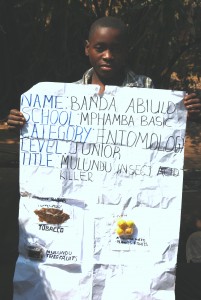by
Mwizenge S. Tembo, Ph. D.
Professor of Sociology
Since the British colonized the then Northern Rhodesia now independent Zambia in late 1800s, we have been made to believe that English is the only, best, and superior language to express thought. We have English as the official language which we use in education from the first grade all the way to secondary school and university. Since Zambia’s independence about 50 years ago, with Zambia now having over 17 universities, we have never really seriously questioned or even explored whether English is the only and best way to express sophisticated thought. What about our 17 major Zambian languages which include Nyanja, Bemba, Tonga, Lozi, Kaonde, and dozens of others? Can they be used to convey sophisticated thought?
Communicating in a Zambian Language Video Clip
I have always known that our indigenous Zambian languages may be best for communicating, exploring, and even for research and development, technical inventions and innovations which we have been erroneously made to believe are only possible using English only. There is a 2.12 minute video clip that has been viewed more than 56,000 times that clearly confirms that we can use our Zambian languages to explain basic principles of electricity as one example. The language the boy used to explain his ideas is Lusaka Nyanja which is the lingua franca of the Capital City of Lusaka. In the video clip, a poor boy from Misisi compound in Lusaka holds a model he had built from discarded material himself to explain basic principles of electricity. https://www.facebook.com/samson.phiri.7/videos/1050732518280060/?pnref=story
He does this in such a surprisingly articulate way, that even I, as a grown man who has a Ph. D but not in electrical engineering, could instantly grasp the principles of electricity from the Kariba Hydroelectric Dam to my own domestic use may be in Lusaka or Kitwe, or Luanshya. Some have suggested that Zesco should have used this boy to explain power shading to the public.
Recommendations
The vast majority of viewers of the video clip comment that Zesco should sponsor the boy, government should sponsor the boy, and some even have said they could individually volunteer to sponsor the boy to get an education. He is clearly a boy who lives in poverty right now. My own reaction is that large institutions like Zesco and especially the Zambian government may already be preoccupied. Samson Phiri who made the video can track down the boy. He can start a fund drive that will first and foremost educate the boy. I would start by donating a hundred dollars myself toward the fund. If there is more money, he can start a program that will educate all the boys and girls who have been found to be as intellectually creative as that boy. There are thousands of talented boys and girls in Zambia who are like the boy in the video. But because of poverty and lack of opportunity, the boys and girls cannot use their creative talents for themselves as well as for the whole nation.

Abiudi Banda in Grade 9 when he was 15 years showing one of his projects in Entomology. He had made an insecticide from natural products; tobacco and 3 other ingredients from the bush.
First and foremost, we have to make sure that corruption is completely removed. If the 56,000 viewers of the video clip each donate just 5 dollars or K65.00, a total of 280,000 dollars or K3.6 million would be raised. If we can keep all the corruption out of this, this would be enough money to educate the boy, but may be hundreds of other boys and girls who have similar creative talent but live in poverty. If we harness this boy’s creative talents, there are also other benefits for you and me and the whole country. There are many possible benefits but I identify the possible two.
Teaching Pedagogy
What the boy is illustrating in the video clip is what is called teaching pedagogy in sophisticated lingo. The boy clearly illustrates teaching methods or how we should teach from the first grade, all through secondary school, up to higher education in colleges and universities. His methodology and simplicity should be incorporated into teaching which may involve bilingualism. This means teaching both in indigenous Zambian languages and English language in order to maximize clarity when explaining a complex subject to anyone especially students in a classroom and even the public. All my fellow teachers from grade one to college lecturers should take note of the basic fundamental principles of this video clip.
Construction of Models
The simple hand held but quite sophisticated model illustrating basic principles of electricity and the power grid can be manufactured on a large scale by Zesco and other manufacturers in Zambia. These models can be of so many different types of sciences which could be sold to thousands of schools. The models could be in biology, physics, chemistry, geography, astronomy, botany, medicine, anatomy, physiology, computers, engineering, and many others. The simple but cheap models could be exported to neighboring and other countries in the world which could also use them in schools, colleges and university. That could create both jobs in the country and exports. Instead of waiting for hard to convince foreign investors, Zambian entrepreneurs, companies, educators, individuals and others could easily join in this very exciting possible profitable venture that could help enhance education.

Abiudi Banda showing me a plastic container which can heat water by inserting electrodes in the container.
Creative Talents in Zambia
There are thousands of young boys and girls in Zambia who have creative talents but live in poverty. One such boy is my own nephew Abiuldi Banda who lives in poverty with his parents, his brothers and sisters in Lundazi. But the boy had incredible creative talents, curiosity and was always experimenting building and testing different models of science from when he was a small boy. Once he completed Grade 12 in 2012, he was admitted to UNZA. But his parents did not have money and the government bursary was not available to him. He is now languishing with wasted talent that he and the nation could benefit from. There are thousands such boys and girls in Zambia. As a nation we just need to harness these talents for the benefit of both the individual boys and girls but also for the entire nation of 13 million people. Mr. Samson Phiri could start the ball rolling without waiting for the government, Zesco, or someone else to start what would be the best project for the nation ever.
Zambian Languages and Sophisticated Idea
If you are still skeptical that Zambian languages can be used to express sophisticated ideas that can only be expressed in English, I believe in practice. I wrote an academic article in

My son Sekani Tembo who was a Third year computer major in at an American College showing his cousins, Abiudi and Nina, a lap top computer behind the Castle Hotel in Lundazi in 2009.
English a few years ago. I translated the abstract into Tumbuka and Nyanja languages. You can try also to translate the abstract into Lozi, Kaonde, Tonga or Bemba Zambian languages. There is a link to the complete academic article in English. The title of the article is: “Eurocentric Destruction of Indigenous Conceptions: the Secret Rediscovery of the Beautiful Woman in African Societies.”
- http://people.bridgewater.edu/~mtembo/menu/articles/BanthuBakaziKukongolaAbstractDec92009.pdf (Nyanja)
- http://people.bridgewater.edu/~mtembo/menu/articles/BanthuBanakaziKutowaAbstractDec92009.pdf (Tumbuka)
- http://people.bridgewater.edu/~mtembo/menu/articles/AfricanBeautyRevisedMarch162010.pdf (Abstract and Full Article in English)

